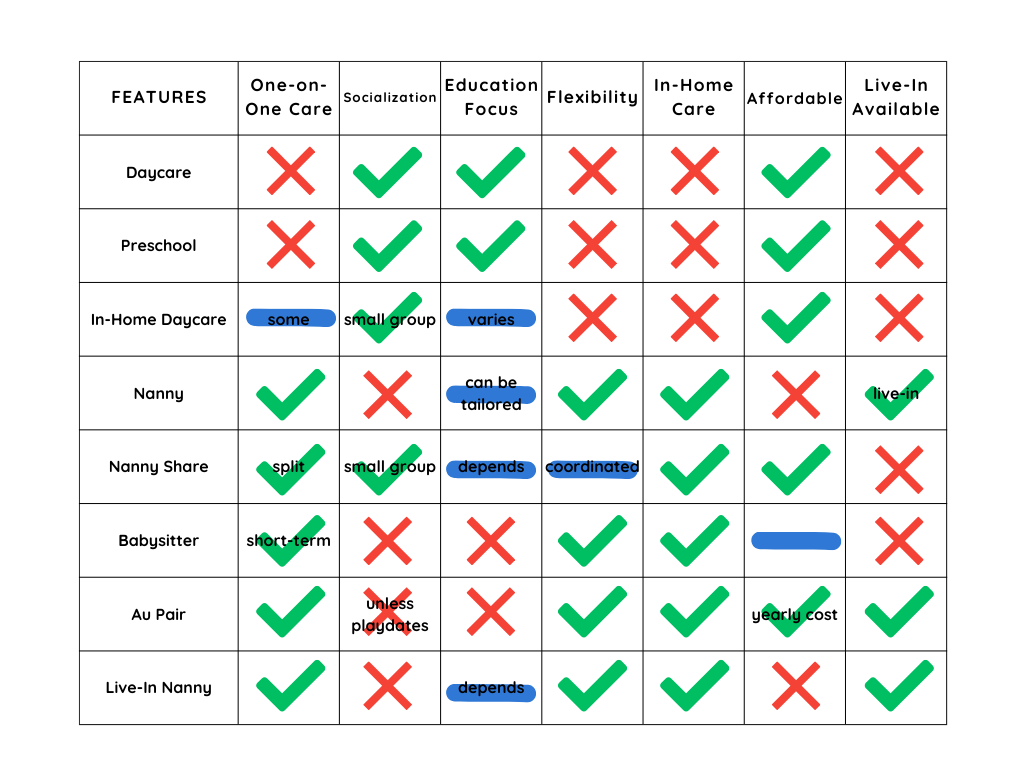The Family Childcare Buffet: Daycare, Nanny, Au Pair & Everything In Between
Welcome to the Childcare Circus (We Mean… Options)
Choosing childcare can feel a lot like trying to pick a favorite flavor at a never-ending ice cream shop—except this decision impacts your work life, your sanity, and, oh yeah, the tiny human you're responsible for. No pressure.
Do you need full-time help or just someone for a few hours here and there? Are you dreaming of structured learning or laid-back snuggles? Is cost your top concern, or is convenience king? Whatever your priorities, we’ve got you covered with a guide to all your options—from daycare to au pairs, nannies to co-ops—with pros, cons, costs, and age recommendations.
Buckle up. This is Childcare 101.
Daycare
What it is: A licensed facility where multiple children are cared for by trained staff.
Pros:
– Built-in socialization and peer play
– Clear structure and routine (great for little minds)
– State regulations = accountability
Cons:
– Less one-on-one attention
– High germ count (prepare for the sniffles)
– Strict pickup/drop-off schedules
Things to Consider:
– Quality can vary—schedule a visit
– Is your child comfortable in group settings?
Average Cost: $250–$400/week
Best Ages: 6 weeks–5 years (especially great for toddlers and preschoolers)
Preschool
What it is: An education-focused program designed to prepare children for kindergarten.
Pros:
– Builds academic and social foundations
– Group play and learning = double win
– Great transition to "big kid school"
Cons:
– Often part-time hours
– Might feel too structured for some kids
Things to Consider:
– What's the teaching style? (Montessori? Play-based?)
– Do you need wraparound care?
Average Cost: $150–$500/week
Best Ages: 3–5 years
In-Home Daycare
What it is: Care provided in the caregiver’s home, usually for a small group of children.
Pros:
– Cozy, homey vibe
– More personalized attention
– Often budget-friendly
Cons:
– Quality varies (check that license!)
– Less access to learning materials
– Closed if the provider is sick
Things to Consider:
– Safety of the space
– Adult-to-child ratio
Average Cost: $150–$300/week
Best Ages: 6 months–3 years
Nanny (In-Home)
What it is: A caregiver who works in your home and focuses solely on your child(ren).
Pros:
– All the one-on-one attention
– Fully customized care and routine
– You don’t have to leave the house for drop-off
Cons:
– Pricier option
– Less peer interaction
– You’re officially an employer (hello, tax forms)
Things to Consider:
– Background checks and solid references are a must
– Are you offering benefits? Paid time off?
Average Cost: $20–$30/hour
Best Ages: Newborn and up
Nanny Share
What it is: Two families share one nanny, splitting costs and time.
Pros:
– More affordable than hiring a nanny solo
– Social play with fewer kids
– More flexible than daycare
Cons:
– Scheduling gymnastics (whose house? what days?)
– Parenting style alignment is essential
– Illnesses = double the exposure
Things to Consider:
– Compatible routines and expectations
– A clear agreement on responsibilities
Average Cost: About ⅔ of a nanny's regular rate per family
Best Ages: 3 months–3 years
Babysitter
What it is: A short-term or occasional caregiver—think date nights, errands, or a couple hours of alone time.
Pros:
– On-demand flexibility
– Easy to book for short stints
Cons:
– Not ideal for full-time care
– Inconsistent if you don’t have a go-to sitter
Things to Consider:
– Will you use an agency, app, or referrals?
– How comfortable is your child with different caregivers?
Average Cost: $15–$25/hour
Best Ages: All ages, for occasional care
Au Pair
What it is: A young international caregiver who lives with your family, provides childcare, and participates in a cultural exchange.
Pros:
– Built-in flexibility and live-in support
– Cultural learning opportunity for your kids
– Can become like family
Cons:
– Must provide housing, meals, and integration into your life
– Limited working hours due to visa rules
– Potential adjustment period for both sides
Things to Consider:
– Do you have the space and bandwidth for a live-in helper?
– Will your lifestyles mesh?
Average Cost: $10,000–$20,000/year (plus room and board)
Best Ages: Newborn–school age
Live-In Nanny
What it is: A professional caregiver who lives with your family and offers full-time childcare (and sometimes household help).
Pros:
– Maximum flexibility
– Deep caregiver-child bond
– Help is always just down the hall
Cons:
– Less privacy
– Added costs for room, board, and benefits
Things to Consider:
– Are you comfortable sharing your space full-time?
– Clear boundaries and expectations are key
Average Cost: $40,000–$60,000/year (plus room and meals)
Best Ages: Newborn–school age
Other Options
Don’t forget these flexible alternatives:
Parent Co-ops: Families take turns watching each other’s kids.
Mother’s Helpers: Great for parents working from home or adjusting to a new baby—extra hands without leaving the house.
Childcare Comparison Chart
Final Thoughts: No One-Size-Fits-All
There’s no “right” answer—only what’s right for your family.
Some families thrive with daycare routines, others need the tailored support of a nanny. Some love the cultural depth an au pair brings, while others swear by their preschool program down the road. Your work schedule, budget, personality, and child’s temperament all play into the mix.
The key is asking good questions, doing your research, and giving yourself permission to pivot if something doesn’t work.
Remember: you're not just choosing childcare—you're choosing peace of mind, support, and a little more room to breathe.
Need help navigating the options?
At Silver Lining Doula & Nanny Services, we make finding the right childcare fit less stressful and more personal. Whether you’re looking for a postpartum doula, a full-time nanny, or an occasional sitter, we’re here to help you find your silver lining.









